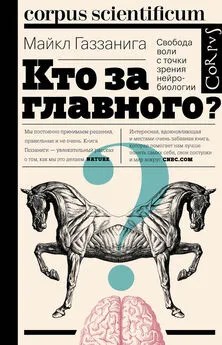Майкл Газзанига - Кто за главного? Свобода воли с точки зрения нейробиологии
- Название:Кто за главного? Свобода воли с точки зрения нейробиологии
- Автор:
- Жанр:
- Издательство:Литагент Corpus
- Год:2017
- Город:Москва
- ISBN:978-5-17-085436-3
- Рейтинг:
- Избранное:Добавить в избранное
-
Отзывы:
-
Ваша оценка:
Майкл Газзанига - Кто за главного? Свобода воли с точки зрения нейробиологии краткое содержание
Кто за главного? Свобода воли с точки зрения нейробиологии - читать онлайн бесплатно ознакомительный отрывок
Интервал:
Закладка:
13
Pomerat C. M. (1963) Activities associated with neuronal regeneration. The Anatomical Record. 145 (2): 371.
14
Krubitzer L. (2009) In search of a unifying theory of complex brain evolution. Annals of the New York Academy of Science. 1156: 44-67.
15
Marler P., Tamura M. (1964) Culturally transmitted patterns of vocal behavior in sparrows. Science. 146 (3650): 1483-1486.
16
Jerne N. (1967) Antibodies and learning: selection versus instruction. The neurosciences: a study program (P. 200-205). NY: Rockefeller University Press.
17
Boag P. T., Grant P. R. (1981) Intense natural selection in a population of Darwin's finches (Geospizinae) in the Galapagos. Science. 214 (4516): 82-85.
18
Sin W. C. et al. (2002) Dendrite growth increased by visual activity requires NMDA receptor and Rho GTPases. Nature. 419 (6906): 475-480.
19
Rioult-Pedotti M. S. et al. (2007) Plasticity of the synaptic modification range. Journal of Neurophysiology. 98 (6): 3688-3695.
20
Xu T. et al. (2009) Rapid formation and selective stabilization of synapses for enduring motor memories. Nature. 462 (7275): 915919.
21
BAILLARGEON R. E. (1987) Object permanence in 3 1/2- and 4 1/2-month-old infants. Developmental Psychology. 23 (5): 655-664.
22
См.: Spelke E. S. (1991) Physical knowledge in infancy: reflections on Piaget's theory. In: Carey S., Gelman R. (eds.) The epigenesis of mind: essays on biology and cognition (P. 133-169). Hillsdale, NJ: Lawrence Erlbaum Associates; а также Spelke E. S. (1994) Initial knowledge: six suggestions. Cognition. 50: 443-447.
23
Purves D. et al. (2004) Perceiving the intensity of light. Psychological Review. 111 (1): 142-158.
24
Purves D. An empirical explanation: simultaneous brightness contrast. См.: http://purveslab.net/simultaneous-brightness-contrast/
25
Lovejoy C. O. et al. (2009) Combmmgprehension and propulsion: the foot of Ardipithecus ramidus. Science. 326 (5949): 72, 72e1-72e8.
26
Festinger L. (1983) The human legacy (P. 4). NY: Columbia University Press.
27
Lovejoy C. O. (2009) Reexamining human origins in light of Ardipithecus ramidus. Science. 326 (5949): 74, 74e1-74e8.
28
Darwin C. (1871) The descent of man, and selection in relation to sex . London: John Murray (Facsimile ed., 1981, Princeton, NJ: Princeton University Press). (Дарвин Ч. Происхождение человека и половой отбор / пер. с англ. Соч. Т. 5. М., 1953.)
29
Huxley T. H. (1863) Evidence as to man's place in nature . London: Williams and Morgate (Reissued, 1959, Ann Arbor: University of Michigan Press). (Гексли Т. Г. О положении человека в ряду органических существ / пер. с англ. под ред. Бекетова А. СПб., 1864.)
30
Holloway R. L. (1966) Cranial capacity and neuron number: a critique and proposal. American Journal of Physical Anthropology. 25 (3): 305-314.
31
Holloway R. L. (2008) The human brain evolving: a personal retrospective. Annual Review of Anthropology. 37: 1-19.
32
См.: Preuss T. M. et al. (1999) Distinctive compartmental organization of human primary visual cortex. Proceedings of the National Academy of Sciences of the United States of America. 96 (20): 11601-11606; а также Preuss T. M., Coleman G. Q. (2002) Human-specific organization of primary visual cortex: alternating compartments of dense Cat-301 and calbindin immunoreactivity in layer 4A. Cerebral Cortex. 12 (7): 671-691.
33
De Winter W., Oxnard C. E. (2001) Evolutionary radiations and convergences in the structural organization of mammalian brains. Nature. 409: 710-714.
34
Oxnard C. E. (2004) Brain evolution: mammals, primates, chimpanzees, and humans. International Journal of Primatology. 25 (5): 1127-1158.
35
Rakic P. (2005) Vive la difference! Neuron. 47 (3): 323-325.
36
Premack D. (2007) Human and animal cognition: continuity and discontinuity. Proceedings of the National Academy of Sciences of the United States of America. 104 (35): 13861-13867.
37
Azevedo F. A. C. et al. (2009) Equal numbers of neuronal and nonneuronal cells make the human brain an isometrically scaled-up primate brain. Journal of Comparative Neurology. 513 (5): 532-541.
38
Shariff G. A. (1953) Cell counts in the primate cerebral cortex. Journal of Comparative Neurology. 98 (3): 381-400.
39
Deacon T. W. (1990) Rethinking mammalian brain evolution. American Zoology. 30 (3): 629-705.
40
Ringo J. L. (1991) Neuronal interconnection as a function of brain size. Brain, Behavior and Evolution. 38 (1): 1-6.
41
Petersen S. E. et al. (1988) Positron emission tomographic studies of the cortical anatomy of single-word processing. Nature. 331 (6157): 585-589.
42
Preuss T. M. (2001) The discovery of cerebral diversity: an unwelcome scientific revolution. In: Falk D., Gibson K.R. (eds.) Evolutionary anatomy of the primate cerebral cortex (P. 154). Cambridge: Cambridge University Press.
43
Hutsler J. J. et al. (2005) Comparative analysis of cortical layering and supragranular layer enlargement in rodent carnivore and primate species. Brain Research. 1052: 71-81.
44
См.: Caviness V. S. et al. (1995) Numbers, time and neocortical neurogenesis: a general developmental and evolutionary mo del . Trends in Neuroscience. 18 (9): 379-383; Fuster J. M. (2003) Neurobiology of cortical networks . In: Cortex and mind (P. 17-53). NY: Oxford University Press; а также Jones E. G. (1981) Anatomy of cerebral cortex: columnar input-output organization . In: Schmitt F. O. et al. (eds.) The organization of the cerebral cortex (P. 199-235). Cambridge, MA: The MIT Press.
45
Hutsler J. J., Galuske R. A. W. (2003) Hemispheric asymmetries in cerebral cortical networks . Trends in Neuroscience. 26: 429-435.
46
Elston G. N., Rosa M. G. P. (2000) Pyramidal cells, patches and cortical columns: a comparative study of infragranular neurons in TEO, TE, and the superior temporal polysensory area of the macaque monkey. The Journal of Neuroscience. 20 (24): RC117.
47
Elston G. N. (2003) Cortex, cognition and the cell: new insights into the pyramidal neuron and prefrontal function . Cerebral Cortex. 13 (11): 1124-1138.
48
Rilling J. K., Insel T. R. (1999) Differential expansion of neural projection systems in primate brain evolution . Neuroreport. 10 (7): 1453-1459.
49
См.: Buxhoeveden D., Casanova M. (2000) Comparative lateralisation patterns in the language area of human, chimpanzee, and rhesus monkey brains . Laterality. 5 (4): 315-330; а также Gilissen E. (2001) Structural symmetries and asymmetries in human and chimpanzee brains . In: Falk D., Gibson K. R. (eds.) Evolutionary anatomy of the primate cerebral cortex (P. 187-215). Cambridge: Cambridge University Press.
50
Vermeire B., Hamilton C. R. (1998) Inversion effect for faces in split-brain monkeys . Neuropsychologia. 36 (10): 1003-1014.
51
Halpern M. E. et al. (2005) Lateralization of the vertebrate brain: taking the side of model systems . Journal of Neuroscience. 25 (35): 10351-10357.
52
См. обзор: Hutsler J. J., Galuske R. A. W. (2003) Hemispheric asymmetries in cerebral cortical networks . Trends in Neuroscience. 26 (8): 429-435.
53
Black P., Myers R. E. (1964) Visual function of the forebrain commissures in the chimpanzee . Science. 146 (3645): 799-800.
54
Pasik P., Pasik T. (1982) Visual functions in monkeys after total removal of visual cerebral cortex . In: Neff W. D. (ed.) Contributions to sensory physiology (V. 7, P. 147–200). NY: Academic Press.
55
Rilling J. K. et al. (2008) The evolution of the arcuate fasciculus revealed with comparative DTI . Nature Neuroscience. 11 (4): 426-428.
56
Preuss T. M. (2003) What is it like to be a human? In: Gazzaniga M. S. (ed.) The cognitive neurosciences III (P. 14-15). Cambridge, MA: The MIT Press.
57
Elston G. N. (2003) Cortex, cognition and the cell: new insights into the pyramidal neuron and prefrontal function . Cerebral Cortex. 13 (11): 1124-1138.
58
Elston G. N. et al. (2006) Specializations of the granular prefrontal cortex of primates: implications for cognitive processing . The Anatomical Record. 288A (1): 26-35.
59
Williamson A. et al. (1993) Comparison between the membrane and synaptic properties of human and rodent dentate granule cells . Brain Research. 622 (1-2): 194-202.
60
Nimchinsky E. A. et al. (1995) Spindle neurons of the human anterior cingulate cortex . Journal of Comparative Neurology. 355 (1): 27-37.
61
Fajardo C. et al. (2008) Von Economo neurons are present in the dorsolateral (dysgranular) prefrontal cortex of humans . Neuroscience Letters. 435 (3): 215-218.
62
Nimchinsky E. A. et al. (1999) A neuronal morphologic type unique to humans and great apes . Proceedings of the National Academy of Sciences of the United States of America. 96 (9): 5268-5273.
63
Allman J. M. et al. (2005) Intuition and autism: a possible role for von Economo neurons . Trends in Cognitive Science. 9 (8): 367-373.
64
Hakeem A. Y. et al. (2009) Von Economo neurons in the elephant brain. The Anatomical Record. 292 (2): 242-248.
65
Hof P. R., van der Gucht E. (2007) Structure of the cerebral cortex of the humpback whale, Megaptera novaeangliae (Cetacea, Mysticeti, Balaenopteridae) . The Anatomical Record. 290 (1): 1-31.
66
Butti C. et al. (2009) Total number and volume of von Economo neurons in the cerebral cortex of cetaceans . Journal of Comparative Neurology. 515 (2): 243-259.
67
Интервал:
Закладка:





